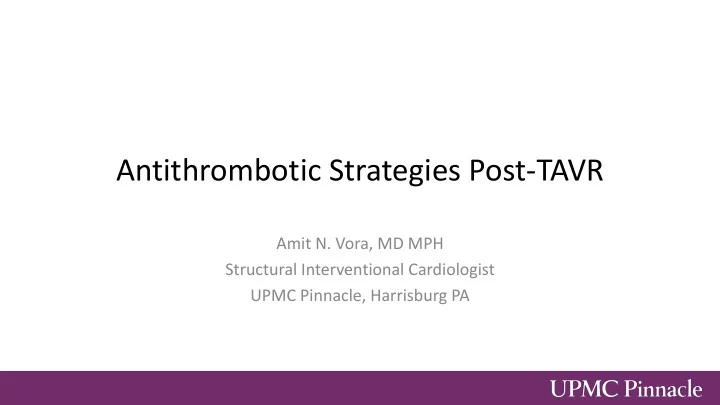

Antithrombotic Strategies Post-TAVR Amit N. Vora, MD MPH Structural Interventional Cardiologist UPMC Pinnacle, Harrisburg PA
Disclosures • Research funding BMS • Education funding: Medtronic
Background • The initial pivotal trials used DAPT for 3-6 months following TAVR (borrowed from PCI) – Prevent device-related thromboembolic complications during endothelialization of the valve frame – Many patients had CAD / arch atheroma • But, need to balance: – Thromboembolic risk (stroke, MI, clinical and sub-clinical valve leaflet thrombosis) – Bleeding risk (especially in elderly, frail patients) • Especially challenging in patients with atrial fibrillation burden
Ischemic and Bleeding Risks Post-TAVR Vranckx, EHJ 2017
Variability in worldwide practice Cerrato et. al, IJC 2017
Combination therapy Antic icoagula oagulati tion on No Antic icoagula oagulati tion on Neither Dual Neither ASA or Therapy ASA or P2Y12 16% P2Y12 11% 14% ASA or Dual P2Y12 Therapy alone 61% 25% ASA or P2Y12 alone 73% Courtesy of M. Sherwood
No real consensus guidelines ACC/AHA • Clopidogrel 75mg daily for 6 months • DAPT for 3-6 months, then SAPT after TAVR in addition to lifelong lifelong (IIa, LOE C) aspirin (IIb, LOE C) • Consider SAPT for high bleeding risk • Anticoagulation with VKA to achieve patients INR of 2.5 for at least 3 months in low bleeding risk patients (IIa, LOE B-NR)
• N=222 patients randomized to ASA + clopidogrel vs SAPT (mostly ASA) • Primary endpoint: Composite of death/MI/stroke, major/life- threatening bleeding at 90d • Trial stopped early (slow enrollment, 74% of inclusion) Rodes-Cabau, JACC Intv 2017
Results • Primary endpoint: – 15.3% vs 7.2% (OR 2.31, 95% CI 0.95-5.62, p=0.065) • No significant differences in: DAPT – Death (6.3% vs 3.6%, p=0.37) – MI (3.6% vs 0.9% p=0.18) – Stroke/TIA (2.7% vs 0.9%, p=0.31) SAPT • Higher bleeding with DAPT (10.8% vs 3.6% OR 3.16, p=0.038) Rodes-Cabau, JACC Intv 2017
Future Trials Guedeney, Circ Intv 2019
POPular-TAVR Trial Design • Primary endpoint: – Freedom from non-procedure related bleeding complications at 1 year • Secondary endpoints: – Net clinical benefit at 1 year: • CV mortality • Non-procedure-related bleeding • Stroke • MI Nijenhuis, AHJ 2016
GALILEO Windecker, AHJ 2017
The ATLANTIS Trial
At our institution No OAC Indicated OAC Indicated • DAPT for 3 months for most but • OAC with no antiplatelet agent if high transitioning to SAPT for high bleeding bleeding risk risk patients – Preference for DOACs (rivaroxaban, apixaban) • DAPT for 6-12 months if recent PCI • OAC with short term SAPT (1-3 • Consideration of OAC alone for months) if lower bleeding risk patients at higher risk for valve leaflet • Almost never triple antithrombotic thrombosis therapy • Strong consideration of WATCHMAN device
Conclusions • Paucity of current data, but more recent data supporting less aggressive antithrombotic therapy • Consider SAPT in many patients, OAC in patients at higher risk for valve leaflet thrombosis • Wealth of new data will be available 2019-2020
Recommend
More recommend